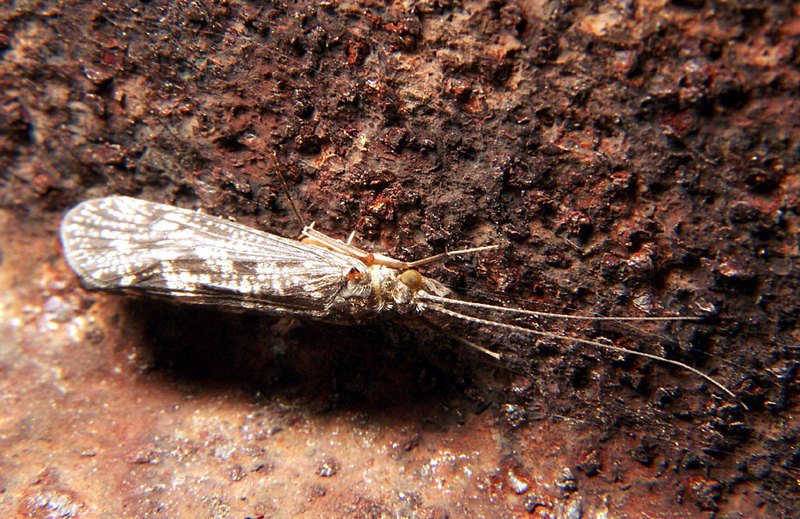Caddisflies (Order Trichoptera) - Wiki Trichoptera
From Wikipedia, the free encyclopedia
[Photo] Adult caddisfly. Source: http://www.cirrusimage.com/Trichoptera_caddisfly.htm Date 05/27/2005. Author Bruce Marlin
Caddisflies (Order Trichoptera, from trich, hair, and ptera, wings) are small moth-like insects having two pairs of hairy membranous wings. They are closely related to Lepidoptera (moths and butterflies) which have scales on their wings, and the two orders together form the superorder Amphiesmenoptera. Caddisflies have aquatic larvae and are found in a wide variety of habitats such as streams, rivers, lakes, ponds, spring seeps, and temporary waters (vernal pools).
Ecology
Caddisflies are considered underwater architects because most species use silt for building throughout their larval life. Caddisflies can loosely be divided into three behavioral groups based on this use of silt: retreat-making caddisflies, case-making caddisflies, and free-living caddisflies. Those that build retreats build a net or retreat from silt and other materials and use it to catch food items algae, aquatic invertebrates and zooplankton from the flowing stream. Case-making caddisflies make portable cases using silk along with substrate materials such as small fragments of rock, sand, small pieces of twig, aquatic plants, or sometimes silk alone. Many use the retreats or cases throughout their larval life, adding to, or enlarging them as they grow. These may look very much like bagworm cases, which are constructed by various moth species that are not aquatic. Free-living caddisflies do not build retreats or carry portable cases until they are ready to pupate.
Although caddisflies may be found in waterbodies of varying qualities, diverse caddisfly assemblages are generally thought of as being indicative of clean water. Together with stoneflies and mayflies, caddisflies feature importantly in bioassessment surveys of streams and other water bodies. Caddisfly species can be found in all feeding guilds in stream habitats, with some species being predators, leaf shredders, algal grazers, and collectors of particles from the watercolumn and benthos.
Development
Many species of caddisfly larvae enter a stage of inactivity called the pupa stage for weeks or months after they mature but prior to emergence. Their emergence is then triggered by cooling water temperatures in the fall, effectively synchronizing the adult activity to make mate-finding easier. In the Northwestern US, caddisfly larvae within their gravel cases are called 'periwinkles.'[2]
Caddisfly pupation occurs much like pupation of Lepidoptera. That is, caddisflies pupate in a cocoon spun from silk. Caddisflies which build the portable cases attach their case to some underwater object, seal the front and back apertures against predation though still allowing water flow, and pupate within it. Once fully developed, most pupal caddisflies cut through their cases with a special pair of mandibles, swim up to the water surface, cast off skin and the now-redundant gills and mandibles, and emerge as fully formed adults. In a minority of species, the pupae swim to shore (either below the water - see figure - or across the surface) and crawl out to emerge. Many of them are able to fly immediately after breaking from their pupal skin.
The adult stage of caddisflies, in most cases, is very shortlived, usually only 1-2 weeks, but can sometimes last for 2 months. Most adults are non-feeding and are equipped mainly to mate. Once mated, the female caddisfly will often lay eggs (enclosed in a gelatinous mass) by attaching them above or below the water surface. Eggs hatch in as little as three weeks.
Caddisflies in most temperate areas complete their lifecycles in a single year. The general temperate-zone lifecycle pattern is one of larval feeding and growth in Autumn, Winter, and Spring, with adult emergence between late spring and early fall, although the adult activity of a few species peaks in the winter. Larvae are active in very cold water and can frequently be observed feeding under ice. In common with many aquatic insect species, many caddisfly adults emerge synchronously en masse. Such emergence patterns ensure that most caddisflies will encounter a member of the opposite gender in a timely fashion. Mass emergences of this nature are called 'hatches' by salmon and trout anglers, and salmonid fish species will frequently 'switch' to whatever species is emerging on a particular day. Anglers take advantage of this behavior by matching their artificial flies to the appropriate fly.
http://en.wikipedia.org/wiki/Trichoptera
| The text in this page is based on the copyrighted Wikipedia article shown in above URL. It is used under the GNU Free Documentation License. You may redistribute it, verbatim or modified, providing that you comply with the terms of the GFDL. |
